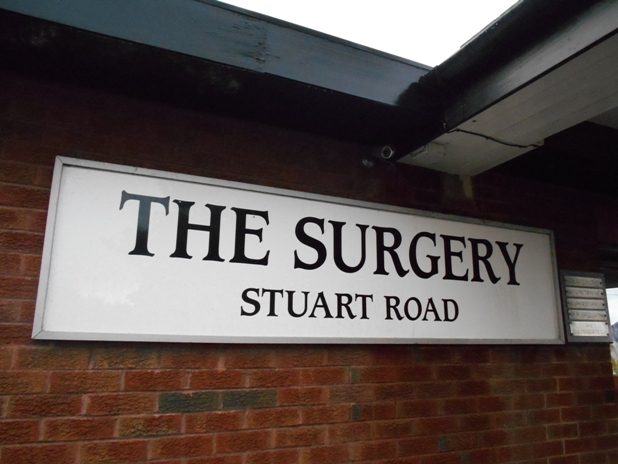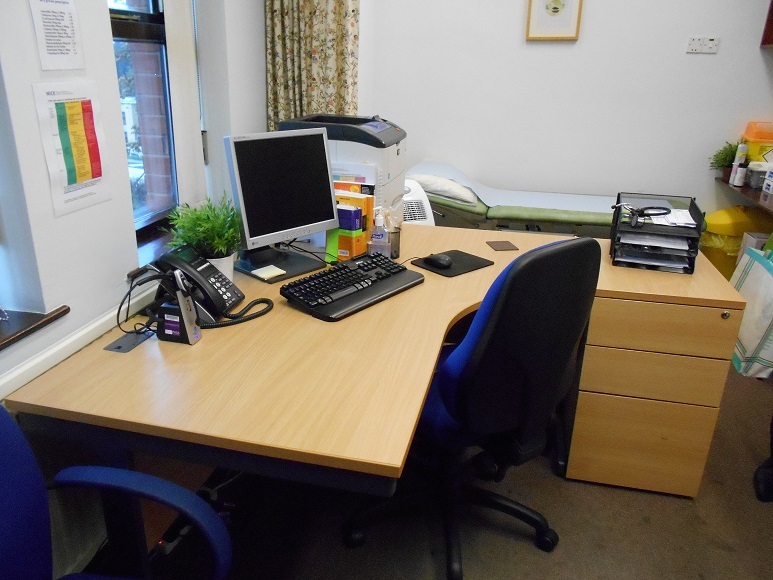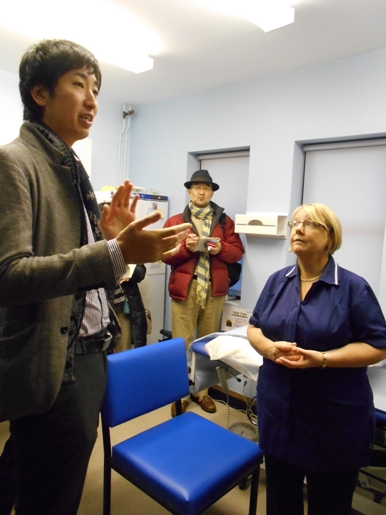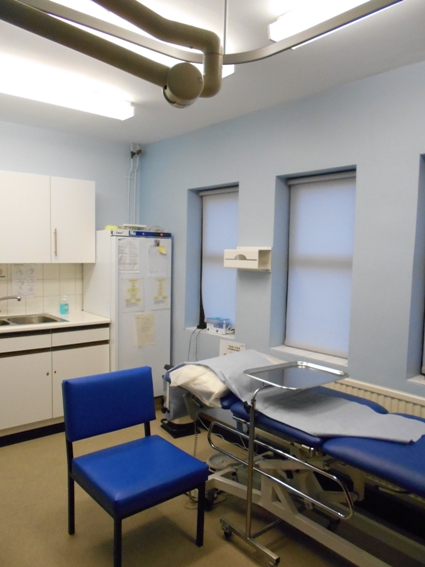Japan’s free-access, fee-for-service health insurance system is proving unsustainable, as growing numbers of aging patients flock to full-service hospitals for expensive tests and treatment. Takashi Mihara looks to Britain’s National Health Service for keys to containing costs while maintaining quality of care and consumer choice.
* * *
In October 2012, the Tokyo Foundation’s project on Crafting the Medical, Nursing-Care, and Social Security Systems of the Future issued a policy proposal on Promoting Community-Based Primary Care calling for sweeping reforms of Japan’s medical and nursing-care systems. Since then, the Foundation has continued to sponsor forums and seminars and solicit the opinions of experts and stakeholders with a view to deepening understanding and spreading awareness of healthcare issues.
On November 18, 2013, the project team hosted a seminar on the primary care system in Britain with special guest Noriaki Sawa, who practices family medicine in Britain. The seminar also featured a report on my own tour of British general practices and nursing facilities the previous month, questions and answers, and discussion.
Of course, a week of study and observation followed by a two-hour seminar do not constitute an exhaustive study, but they did yield some preliminary observations pertinent to healthcare reform in Japan. Those observations are the subject of this article.
Free Access versus Gatekeeping
Britain’s taxpayer-funded National Health Service provides all legal residents with healthcare free at the point of service. (In Japan, healthcare is administered under a system of universal health insurance, funded by premiums rather than taxes.) Under the NHS, community-based family physicians known as general practitioners, or GPs, are responsible for primary care.

Even during my limited tour of British healthcare facilities I became acutely aware of the central role of these GPs, who, in addition to their other duties, pay regular visits to nursing homes for on-site examinations and assist in the implementation of Britain’s national dementia strategy. All British citizens are required to register with a local GP surgery, or practice, and the process of consultation, diagnosis, and treatment begins, as a rule, with an appointment at that surgery.
In Japan, by contrast, where care is usually offered by specialists, consumers have open access to the entire spectrum of licensed healthcare providers and facilities—from neighborhood offices and clinics to university hospitals. Because Japanese health insurance pays for walk-in consultations, tests, and examinations at any facility the patient chooses, at any time during regular hours, healthcare consumers rely increasingly on big hospitals even for routine examinations and minor problems, making unfettered use of costly specialist services.
Recently, however, the Japanese government has begun laying the groundwork for reform. The August 2013 report of the National Council on Social Security System Reform stressed the need for the kind of holistic approach to medical care embodied in general practice. Work has begun on a new professional training and certification program for “general physicians” ( sogo shinryo i ), scheduled to go into effect in 2017. [1]
In this connection, the Tokyo Foundation’s October 2012 policy proposal stressed the need for community-based professionals who can fill the role of patient advocate and recommended that Japan learn what it can from Britain’s solidly established system of community-based primary care centered on general practitioners.
With this purpose in mind, let us begin by examining the function of GPs in the British healthcare system.
Promoting Doctor-Patient Dialogue
What struck me most during my tour of British healthcare facilities were the GPs’ examination rooms. The average GP appointment is 10 minutes long, and during this time the emphasis is on two-way communication with the patient. This focus on dialogue is reflected in examination rooms that resemble counseling offices in their relaxed, comfortable atmosphere and lack of bulky medical equipment, such as CT scanners, which often clutters clinics in Japan.

How, then, do these examinations proceed? At the November seminar, Dr. Sawa illustrated the British GP’s approach using the example of a patient who comes in complaining of a severe headache and insists on a CT scan, even though it seems clear to the doctor that the cause is a common cold.
In Japan, most doctors would either dismiss the request peremptorily or yield to the patient’s demands. British GPs, however, are trained to engage the patient in dialogue. Upon asking why the patient feels a CT scan is necessary, the GP may discover that the patient’s father died prematurely from a cerebral hemorrhage. Then the doctor can reassure and persuade the patient using evidence-based arguments, explaining that the most likely cause is a cold, that the probability of finding a cerebral hemorrhage with a CT scan is close to nil, and that such scans expose the body to levels of radiation more than 100 times that of a chest X-ray. The final decision is left to the patient.
Speaking at a Tokyo Foundation forum held the previous May, Sawa explained that the role of the British GP often transcends the conventional boundaries of medical care. “Often, when an examination fails to reveal any medical condition, the symptoms can be traced to daily stress and lifestyle issues. During consultation, the patient may refer to family problems—complaining, for example, that her husband doesn’t help out with the housework or childcare. In such cases, the GP can refer the patient to a family counselor, encourage the person to take time off from work, or help the person secure assistance through social services.”
By building long-term relationships with patients and fostering an atmosphere of honest dialogue, GPs encourage their patients to open up about any number of concerns that may be affecting their quality of life or that of their family, from a husband’s fierce temper to a child’s junk-food addiction. This puts them in a position to suggest solutions that most Japanese physicians would consider beyond their purview, including strategies for minimizing the workplace stress that may be causing a patient’s headaches or addressing the family issues underlying a patient’s emotional problems.
At the November seminar, Sawa discussed his own initial difficulty adjusting to the British approach, coming from a country where hospital-based care has become the norm. “When I began my postgraduate training, I had a tendency to adopt a hospitalist’s approach when examining patients,” he said. “For example, if a patient was suffering from a little vertigo, even if there were no other major symptoms, I was inclined to make a tentative diagnosis and order a battery of tests. But my supervising doctor let me know that that sort of approach wasn’t considered appropriate for primary care—that British generalists had their own special way of handling things.”
As we in Japan begin deliberating standards for the training and licensing of general physicians, we need to think about ways of nurturing primary-care physicians as holistic practitioners focused on dialogue-based problem solving, instead of devoting all our energy to delimiting their professional turf or defining the necessary diagnostic skills.
Respecting Patient Choice
Another important aspect of the British primary care system today is its policy of treating healthcare as a doctor-patient partnership, offering patients a set of options and empowering them to make evidence-based choices, instead of placing all power in the hands of the doctor. The aim is both to raise patients’ awareness and to get them to share responsibility for their own care. Community-based primary care should be predicated on patient choice, not unilateral decisions by the primary care physician.

To be sure, few healthcare consumers can fully grasp the complexities of today’s advanced medical science. To borrow the terminology of economics, a certain degree of “information asymmetry” will always persist. But Britain’s healthcare system has a variety of mechanisms designed to support informed consumer choice—one way in which the system selectively incorporates market principles to create a healthcare “quasi-market.” Let us examine these mechanisms.
Where previously each household was assigned to a GP surgery according to location, British healthcare consumers today have a right to choose from any qualified general practice in their district. The GP Patient Survey website permits them to search practices by name and location to see how existing and previous patients have rated their experience via the GP Patient Survey, conducted annually. Survey questions include the following.
- Did you have confidence and trust in the GP you saw or spoke to?
- Is your GP surgery currently open at times that are convenient for you?
- Last time you saw or spoke to a GP from your GP surgery, how good was that GP at the following? a. Involving you in decisions about your care; b. . . .
- Would you recommend your GP surgery to someone who has just moved to your local area?
In addition, users can access a variety of data about providers on the NHS Choices website ( http://www.nhs.uk/Pages/HomePage.aspx ) by doing a search on the name or location of the practice. A search on the name of Dr. Sawa’s surgery yielded such basic data as the address and telephone number, hours, and disabled access, along with the names of the five GPs who practice there. The website also provided such helpful information as the number of female physicians, languages spoken other than English, and patient survey results and scores.
According to Sawa, the principle of patient choice also extends to secondary care. Patients who are referred for hospital treatment by their GP can choose an area hospital with the help of a five-star rating system. Speaking at the November seminar, Sawa explained, “There are three hospitals near my surgery, and any patient I refer is given a password that permits him or her to make an appointment online. The website provides information about each of the three hospitals, including the waiting times, so that patients can choose the one that’s best for them.”
Of course, Japan’s free-access system offers greater freedom of choice, but it lacks a built-in mechanism for rating and comparing facilities with respect to patient and family satisfaction. Instead, consumers rely on word-of-mouth or magazine rankings (as well as general geographical considerations) when selecting a facility, and as a consequence they inevitably gravitate to the large regional or national hospitals. [2]
The August 2013 report by the government’s National Council on Social Security System Reform expresses concern that the current healthcare system will “cease to function if patients continue to gravitate toward large, elaborately equipped hospitals.” It recommends measures to encourage hospital specialization and to promote “flexible gatekeeping” by primary care physicians with whom patients have established an ongoing relationship. It also suggests increasing the fee for an initial consultation at a large hospital unless the patient has a written referral from such a primary care physician.
It seems to me, however, that the preference for large hospitals is unlikely to change until the public gains greater confidence in local primary care doctors and facilities. For this to happen, Japan needs to implement systemic reforms to facilitate informed patient choice, including fuller disclosure of information and a more user-friendly and detailed quality rating system.
Incentivizing Cost-Effective Quality Care
Another systemic reform that could expand the role of GPs in Japan is a capitation payment system similar to that used in Britain. Roughly 70% of the NHS’s funding of general practices is in the form of capitation payments tied to the number of community residents registered at each surgery. This method guarantees a basic income for GPs and—unlike Japan’s fee-for-service reimbursement system—eliminates financial incentives to over-treat and over-test in order to recover personnel and equipment costs.
The risk with capitation is that it could encourage providers to skimp on needed services, since a practice receives the same amount per patient regardless of the level of care it provides. To prevent this from happening and ensure high-quality care, NHS payments also have a performance-based component (roughly 30% of the total) calculated according to various quality-care indicators set forth in the Quality and Outcome Framework (QOF).
The QOF system hinges on the widespread use of a standardized electronic medical record system. In Britain, GPs keep digital charts that include each patient’s complete medical history, records of previous examinations, and dates of future appointments. If the patient undergoes hospital testing or treatment, the results are relayed to the GP electronically when the patient checks out, ensuring seamless follow-up care.
These same electronic records are used to assess the health status of a practice’s patients and assess treatment quality and preventive care using the QOF indicators. Practices that record improvements in those indicators are rewarded with higher payments.
At the November seminar, Dr. Sawa explained how electronic records are used to manage and monitor preventive care. Patients with high blood pressure, for example, are tagged with a standard code. With the help this code, one can quickly determine the number of patients in a given practice that have high blood pressure and track their readings without compromising patient privacy. A rise in the percentage of those patients in whom the last recorded blood pressure was 150/90 or lower will result in an increase in the QOF payment the practice receives from the NHS.
“The latest evidence shows that influenza immunization offers very few benefits for healthy, young people like me,” Sawa elaborated, “but considerable benefits for people 65 or older and for people with asthma and other chronic conditions.” Electronic records allow the surgery to identify its high-risk patients and notify them by mail when it is time to come in for a flu shot. The percentage of high-risk patients who receive shots affects the practice’s QOF payment. In addition, prospective patients can go online to check the performance of a given GP surgery on various QOF indicators and use that information when choosing a primary care provider.
Standardizing Quality of Care
The QOF indicators are based largely on recommendations from NICE (the National Institute for Health and Care Excellence), an independent public agency involved in the development of evidence-based clinical standards. NICE also provides professional healthcare providers with guidance on the most cost-effective treatment for various conditions, in some cases advising against the use of a particular drug or procedure. Meanwhile, the Care Quality Commission (CQC) monitors hospitals, nursing homes, and other healthcare facilities to ensure that they meet national standards.
Together, these frameworks are contributing to the standardization of healthcare quality throughout Britain, ensuring that people all over the country have access to the same high-quality care. As Sawa noted in his seminar remarks, GPs are acutely aware that their performance is being monitored and evaluated, whether by NICE, the CQC, or the GP Patient Survey. In addition, the GPs at his surgery are continually discussing and reviewing their outcomes with the aid of electronic records.
Here in Japan, where the topic of healthcare reform tends to focus almost exclusively on cost issues, policymakers should pay heed to the way Britain has balanced measures designed to control costs with systems aimed at enhancing patient satisfaction and medical outcomes through quality assurance and standardization of care.
Delegating Care to Qualified Nurses

Finally, the British system depends heavily on the contribution of general practice nurses, who form an integral part of the primary healthcare team at each GP surgery. The practice nurses at Sawa’s surgery have their own examining rooms, complete with examination tables and an entire array of examining equipment. Indeed, the nurses’ rooms conform more closely to the Japanese image of a doctor’s office than the GPs’ rooms.
According to Dr. Sawa, practice nurses are highly experienced healthcare professionals who are qualified to diagnose and treat small injuries and minor illnesses, undertake simple medical procedures like wart removal, advise patients on the management of chronic conditions, and dispense medication. Registered nurses must undergo six months of additional training to qualify as practice nurses at Sawa’s surgery. When patients make appointments, they are routinely asked whether they want to see a GP or a practice nurse, and the majority end up requesting a nurse. The results of any examination by a GP nurse are recorded in the electronic medical record to ensure continuity of care.
In the Netherlands, another country that has built a sustainable healthcare system based on community-based primary care, visiting nurses play a pivotal role in healthcare delivery. Data from both countries support the notion that delegating authority to qualified nurses can lighten doctors’ workload, improve the efficiency of healthcare delivery, and lead to higher patient satisfaction.
In Japan, however, even the most highly trained nurses have very little latitude to act on their own authority. Reforms currently in the works will allow registered nurses to provide dietary and other lifestyle guidance to diabetic patients on the basis of a physician’s written instructions and permit those who have passed a special nationally accredited training course to carry out such emergency procedures as tracheal intubation and administration of intravenous fluids on their own authority. Unfortunately, however, the government has opted against more substantive reform via the institution of a nurse practitioner system.
Among the topics left largely unaddressed during my tour and the subsequent seminar was the planning and purchasing of NHS services to meet the health needs of the local population, a role that has passed from primary care trusts to clinical commissioning groups (previously known as GP consortiums). In addition, further study will be needed to clarify the role of NICE and CQC in standardization and quality assurance, the calculation of capitation and QOF payments, and other components of Britain’s primary care system. As an independent not-for-profit think tank, the Tokyo Foundation will continue working to deepen understanding and raise awareness of the primary care system in Britain and elsewhere in an effort to contribute to the development of a sustainable community-based healthcare system in Japan.
[1] The Japanese sogo shinryo i does not correspond exactly to the British general practitioner, as the former encompasses hospitalists specializing in general internal medicine as well as community-based primary care providers.
[2] The Japan Council for Quality Health Care does carry out evaluation and accreditation of hospitals, but the council’s focus is on improvement of hospital management, not patient choice. With regard to nursing-care facilities, the Ministry of Health, Labor, and Welfare administers a Nursing Service Public Information System that provides basic information for services qualifying for reimbursement under Japan Long-term Care Insurance System, along with the results of third-party evaluations.
